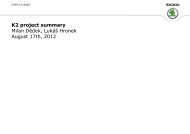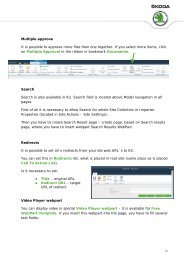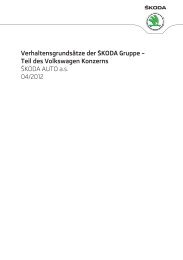Å kodaAuto ANNUAL REPORT 2006 - Skoda Auto
Å kodaAuto ANNUAL REPORT 2006 - Skoda Auto
Å kodaAuto ANNUAL REPORT 2006 - Skoda Auto
You also want an ePaper? Increase the reach of your titles
YUMPU automatically turns print PDFs into web optimized ePapers that Google loves.
(c) Held-to-maturity investments<br />
Held-to-maturity investments are non-derivative financial assets with fixed or determinable payments and fixed maturities that the<br />
Company’s management has the positive intention and ability to hold to maturity. During the years presented in these separate financial<br />
statements the Company did not hold any investments in this category.<br />
(d) Available-for-sale financial assets<br />
Available-for-sale financial assets are non-derivatives that are either designated in this category or not classified in any of the other<br />
categories. They are included in non-current assets unless management intends to dispose of the investment within 12 months of the<br />
balance sheet date.<br />
Purchases and sales of financial assets are recognised on trade-date – the date on which the Company commits to purchase or sell the<br />
asset. Financial assets are initially recognised at fair value plus transaction costs for all financial assets not carried at fair value through<br />
profit or loss. Financial assets carried at fair value through profit or loss are initially recognised at fair value, and transaction costs are<br />
expensed in the income statement. Financial assets are derecognised when the rights to receive cash flows from the investments have<br />
expired or have been transferred and the Company has transferred substantially all risks and rewards of ownership. Available-for-sale<br />
financial assets and financial assets at fair value through profit or loss are subsequently carried at fair value. Loans and receivables and<br />
held-to-maturity investments are carried at amortised cost using the effective interest method.<br />
The fair values of quoted financial assets are based on current bid prices. The fair value of financial instruments that are not traded in an<br />
active market (for example, over-the counter derivatives) is determined by using valuation techniques. The Company uses a variety of<br />
methods and makes assumptions that are based on market conditions existing at each balance sheet date. The fair value of interest rate<br />
swaps and forward foreign exchange contracts is calculated as the present value of the estimated future cash flows. If the market for an<br />
equity instrument is not active (or the equity instrument is unlisted) and it is not possible to determine fair value, then these instruments<br />
are valued at purchase costs.<br />
Realised and unrealised gains and losses arising from changes in the fair value of the financial assets at fair value through profit or loss’<br />
category are presented in the income statement in financial income/ financial expenses in the period in which they arise. Unrealised gains<br />
and losses arising from changes in the fair value of monetary and non-monetary securities classified as available-for-sale are recognised in<br />
equity. When securities classified as available-for-sale are sold or impaired, the accumulated fair value adjustments are included in the<br />
income statement as a part of gain and losses on disposal.<br />
The Company assesses at each balance sheet date whether there is objective evidence that a financial asset or a group of financial assets is<br />
impaired. In the case of equity securities classified as available for sale, a significant or prolonged decline in the fair value of the security<br />
below its cost is considered as an indicator that the securities are impaired. If any such evidence exists for available-for-sale financial<br />
assets, the cumulative loss – measured as the difference between the acquisition cost and the current fair value, less any impairment loss<br />
on that financial asset previously recognised in profit or loss – is removed from equity and recognised in the income statement.<br />
A provision for impairment of trade receivables is established when there is objective evidence that the Company will not be able to<br />
collect all amounts due according to the original terms of receivables. Significant financial difficulties of the debtor, probability that the<br />
debtor will enter bankruptcy or financial reorganization, and default or delinquency in payments are considered indicators that the trade<br />
receivable is impaired. The amount of the provision is the difference between the asset’s carrying amount and the present value of<br />
estimated future cash flows, discounted at the effective interest rate. The amount of the provision is recognized in the income statement<br />
within other operating expenses.<br />
(e) Investments in subsidiaries and associates<br />
Investments in subsidiaries and associates are carried in these separate financial statements at cost.<br />
105

















